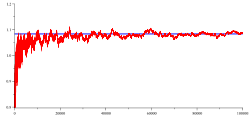Legendre's constant

Legendre's constant is a mathematical constant occurring in a formula conjectured by Adrien-Marie Legendre to capture the asymptotic behavior of the prime-counting function  . Its value is now known to be exactly 1.
. Its value is now known to be exactly 1.
Examination of available numerical evidence for known primes led Legendre to suspect that  satisfies an approximate formula.
satisfies an approximate formula.
Legendre conjectured in 1808 that
Or similarly,
where B is Legendre's constant. He guessed B to be about 1.08366, but regardless of its exact value, the existence of B implies the prime number theorem.
Pafnuty Chebyshev proved in 1849[2] that if the limit B exists, it must be equal to 1. An easier proof was given by Pintz in 1980.[3]
It is an immediate consequence of the prime number theorem, under the precise form with an explicit estimate of the error term
(for some positive constant a, where O(…) is the big O notation), as proved in 1899 by Charles de La Vallée Poussin,[4] that B indeed is equal to 1. (The prime number theorem had been proved in 1896, independently by Jacques Hadamard[5] and La Vallée Poussin,[6] but without any estimate of the involved error term).
Being evaluated to such a simple number has made the term Legendre's constant mostly only of historical value, with it often (technically incorrectly) being used to refer to Legendre's first guess 1.08366... instead.
Pierre Dusart proved in 2010
 for
for  , and
, and
 for
for  .[7] This is of the same form as
.[7] This is of the same form as
 with
with  .
.
References
- ↑ Ribenboim, Paulo (2004). The Little Book of Bigger Primes. New York: Springer-Verlag. p. 188. ISBN 0-387-20169-6.
- ↑ Edmund Landau. Handbuch der Lehre von der Verteilung der Primzahlen, page 17. Third (corrected) edition, two volumes in one, 1974, Chelsea 1974
- ↑ J. Pintz. On Legendre's prime number formula. Amer. Math. Monthly 87 (1980), 733-735.
- ↑ La Vallée Poussin, C. Mém. Couronnés Acad. Roy. Belgique 59, 1-74, 1899
- ↑ Sur la distribution des zéros de la fonction
 et ses conséquences arithmétiques, Bulletin de la Société Mathématique de France, Vol. 24, 1896, pp. 199–220 Online
et ses conséquences arithmétiques, Bulletin de la Société Mathématique de France, Vol. 24, 1896, pp. 199–220 Online - ↑ « Recherches analytiques sur la théorie des nombres premiers », Annales de la société scientifique de Bruxelles, vol. 20, 1896, p. 183-256 et 281-361
- ↑ Dusart, Pierre. "ESTIMATES OF SOME FUNCTIONS OVER PRIMES WITHOUT R.H.". arxiv.org. Retrieved 22 April 2014.

 ....
....
